Note: This website was automatically translated, so some terms or nuances may not be completely accurate.
DENTSU SOKEN INC. Conducts "Youth × Work" Survey
DENTSU SOKEN INC., as the third installment of its "☐×Work" study researching and proposing "Japan's Current and Future Work Styles" following "Women×Work" and "Seniors×Work," focused on the employment perspectives of "young people" – the generation that will shoulder society's future. In collaboration with Dentsu Inc.'s Youth Research Department (Wakamon), it conducted the "Youth×Work" survey.
This survey targeted3,000 men and womenaged 18-29working at least three days per week. By comparing their data with that of 2,400 men and women aged 30-49, it revealed young people's current work styles, their purposes for working, and their attitudes toward work.
The findings revealed that one in two 18- to 29-year-olds expressed dissatisfaction with aspects like salary and benefits. Regarding their purpose for working, while "stable income" was cited by about 70% as their "reality," their "ideal" purpose showed a positive mindset, with many wanting to "find meaning in life."
Regarding attitudes toward work, while about 40% consider working a given, nearly 30% would prefer not to work if possible.
Regarding company and job selection, while 37.1% want to work for a stable company, the desire to stay with one company for life is low (17.3%). There is also a desire to work remotely while belonging to a company or in an environment where working hours can be chosen.
The main findings of this survey are as follows.
1. Approximately 30% of young people are in non-regular employment. Among women, this figure is about 40%.
2. Common work dissatisfactions include compensation and benefits, difficulty taking paid leave, and job content.
3. The primary purpose of working is to ensure financial stability. However, they also desire a sense of purpose from their work.
4. Current work styles are steady, but the ideal is to try flexible work arrangements.
5. About 40% consider working a given, while about 30% would prefer not to work if possible. They want to work for a stable company, but the desire to stay with one company forever is low.
6.When asked what "society" means to them in the context of "working for society," they imagine "Japan" and "their local community."
7. Young people are unfamiliar with terms like "corporate warrior" or "workaholic employee."
[Survey Results Details] (N=Actual number of respondents)
*Weighted back calculations were performed based on the working population composition of the target area.
※Scores in the chart are rounded to the second decimal place, so totals may not add up to 100%.
1. Approximately 30% of young people are non-regular employees. Among women, this figure rises to about 40%.
●Approximately 30% of those aged 18-29 are in non-regular employment. Among women aged 18-29, this figure is approximately 40%. (Figure 1)
When asked about their current employment status, 63.6% of those aged 18-29 were regular employees (full-time or permanent), 32.1% were non-regular employees (contract workers, temporary agency workers, part-time/casual workers), and 4.1% were self-employed (including freelancers).
The proportion of non-regular employment shows a significant gender gap: 22.8% for men aged 18-29 versus 42.6% for women aged 18-29. Notably, women aged 18-49 show non-regular employment rates exceeding 40% across all age groups.
Figure 1: Current Employment Status
[Question] Please indicate your current employment status. (Single answer)
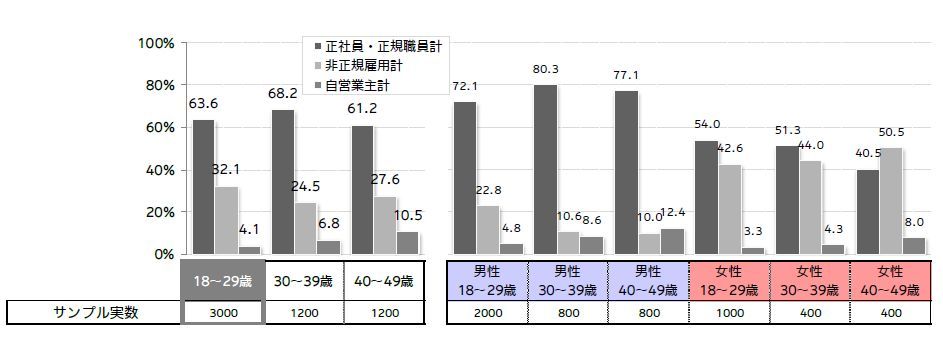
2. Common work dissatisfactions include compensation and benefits, difficulty taking paid leave, and job content.
● Across all age groups, one in two workers expressed dissatisfaction with low wages or bonuses. (Figure 2)
When asked about workplace dissatisfaction, the top reasons among those aged 18-29 were "low salary or bonuses" (50.4%), "difficulty taking paid leave" (23.8%), and "work becoming monotonous" (17.6%).
While "low salary and bonuses" ranked high across all age groups, the scores for "difficulty taking paid leave," "long commutes," and "excessive overtime" were higher among younger age groups.
Figure 2: Dissatisfaction with Work
Question: Do you have any dissatisfaction with your current job? Please select all that apply. (Multiple answers)
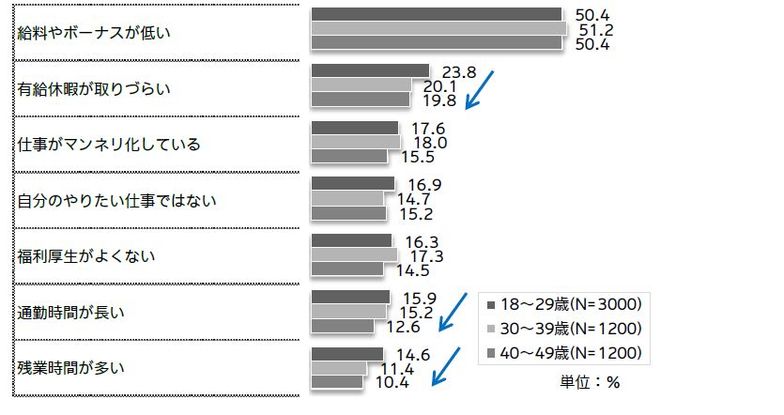
3. The primary purpose of working is financial stability. While working, people also want to find a sense of purpose.
● Reality: Working for stability and hobbies. Ideal: Gaining a sense of purpose through work. (Figure 3)
When asked about current work purposes, the top responses among those aged 18-29 were "For stable income" (69.3%), "To earn money for hobbies or leisure" (36.5%), and "For future (during working years) living expenses" (30.5%), clearly showing financial stability as the primary goal.
For ideal purposes, the top two items remain unchanged, but "to gain a sense of purpose" ranks highly.
Figure 3: Purpose and Motivation for Working
[Question]
Reality: (1) Please list all your current purposes/motivation for working. (Multiple answers)
Ideal: (2) Please list all purposes you would like to work for if you could choose, regardless of your current job or work style. (Multiple answers)
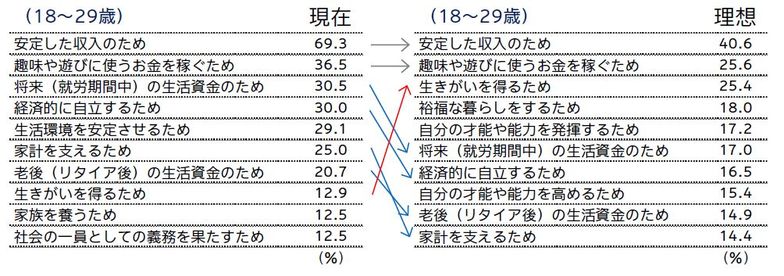
4. I want to work steadily in my current job, but ideally I'd like to try flexible work arrangements.
● I would like to try diverse and flexible ways of working if possible. (Figure 4)
Among current work styles, top responses include "Working to reliably achieve goals set by the company or workplace" (21.1%) and "Working in my hometown or regional area, even if the salary is modest" (15.0%).
Regarding desired work styles, a significant number of young people expressed interest in diverse and flexible options, such as "working from home while employed by a company" (19.7%) and "working in an environment where hours can be chosen based on the worker's circumstances" (16.4%).
Figure 4: Current Work Style / Desired Work Style
[Question]
(1) What kind of work arrangements do you currently have? Please select all that apply.
(2) Please indicate all work styles you would like to try yourself in the future, regardless of whether you currently do them or not. (Multiple answers)


5. Approximately 40% consider working a given, while about 30% would prefer not to work if possible. While desiring to work for a stable company, the desire to stay with one company for life is low.
● The percentage wanting to work for a stable company is higher among women. (Figure 5)
Regarding attitudes toward work, about 40% of those aged 18-29 believe "working is a given" (39.1%), while nearly 30% feel "would rather not work if possible" (28.7%). Regarding work values, while there is a passive mindset such as "I want to view work purely as a means to earn money" (40.4%), there is also an awareness that "I want to decide my own working style as much as possible" (28.4%).
Regarding company and job selection, the desire to "work for a company that is as stable as possible" (37.1%) is strong, but the desire to "work for one company for my entire career" is only 17.3%.
Regarding interactions with others and society, 32.9% want to "work only with colleagues who share their values as much as possible," and 23.2% want to "choose work or companies that contribute to society."
The desire to "work for a company that is as stable as possible" is particularly high among women aged 18-29, at 44.3%.
Figure 5: Attitudes Toward Work
[Question] Please select all that apply to your views. (Multiple answers)
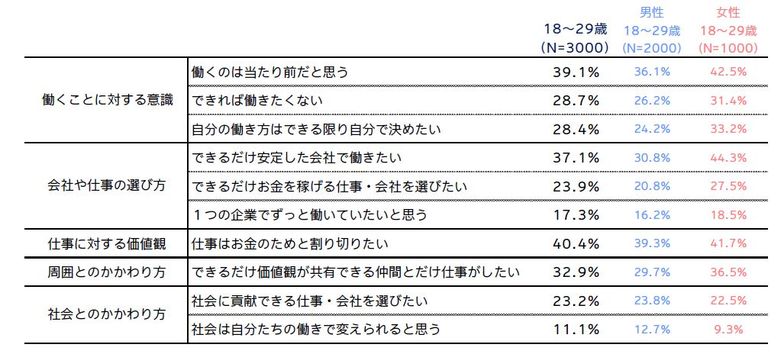
6. When hearing "working for society," the "society" imagined is "Japan" and "local community"
● The scope of "society" varies by individual (Figure 6)
Among those aged 18-29, the top associations with the word "society" were: "Japanese society" (41.9%), "company or group one belongs to" (39.2%), "the local area where one lives or has connections" (34.8%), and "friends and family" (34.1%). This shows that while society is often equated with Japan, people also envision close-knit "societies" like friends and family.
Among women aged 18-29, "company or group they belong to" (42.6%) ranked highest, indicating they perceive their immediate community as society.
Figure 6: Images Closest to the Word "Society"
Question: When you think about "working for society" or "contributing to society," which image is closest to your understanding of "society"? (Multiple answers)
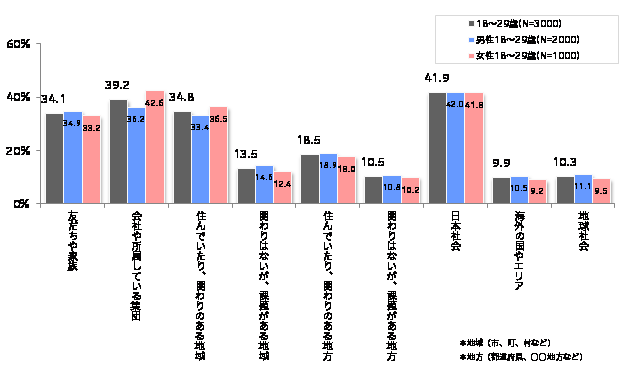
7. Young people are unfamiliar with terms like "corporate warriors" and "workaholic employees."
● "Corporate warriors" and "workaholics" unknown to young people. (Figure 7)
When asked about familiarity with work-related terms, awareness of "corporate warrior" was 53.6% among those aged 40-49, compared to 31.2% among those aged 18-29. Similarly, awareness of "workaholic employee" was 54.4% among those aged 40-49, compared to 21.7% among those aged 18-29, showing a significant generational gap.
These terms represent the image of salarymen who were intensely dedicated to their work and worked tirelessly for their companies during the high-growth era, highlighting a generational gap.
Figure 7: Work-Related Terms
Question: Are you familiar with the following terms related to work styles? (Single answer per term)
Options: Know both the term and its meaning / Know the term but not its meaning / Know the meaning but not the term / Don't know
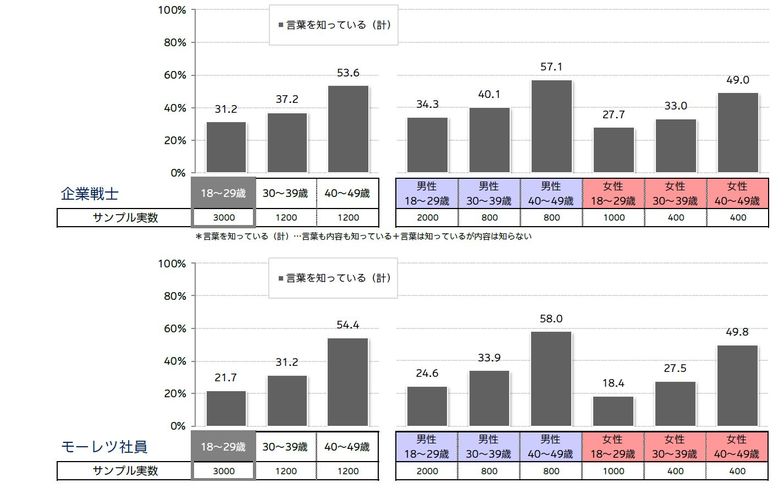
■ "Youth × Work" Survey Overview
・Survey Participants: Working individuals aged 18-49, male and female, working 3 or more days per week
・Target Area: Nationwide
・Sample Size: 5,400 respondents

・Survey Method: Internet survey
・Survey Company: Video Research Ltd.
Dentsu Inc. News Release
http://www.dentsu.co.jp/news/release/2015/0813-004113.html
Was this article helpful?